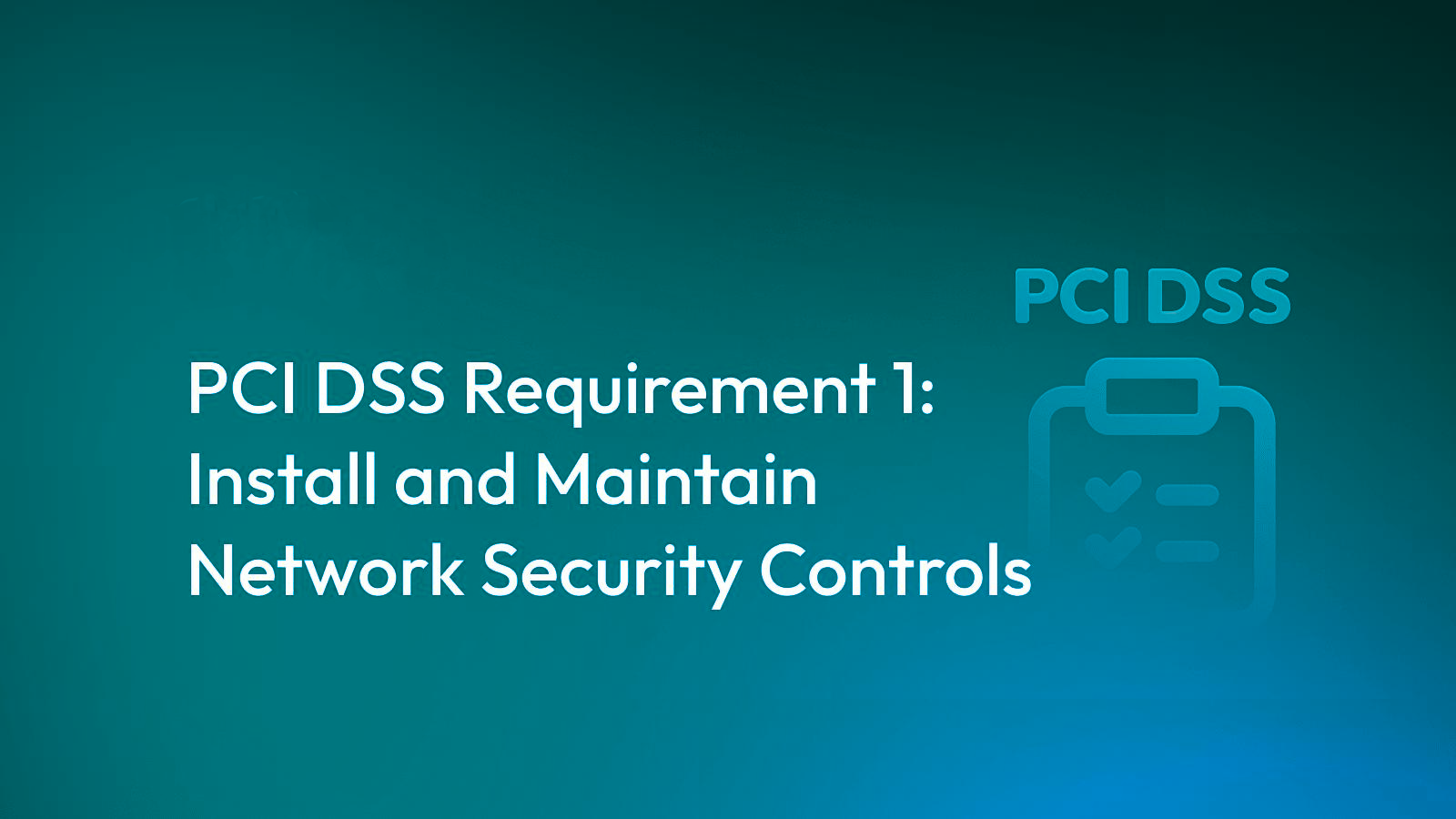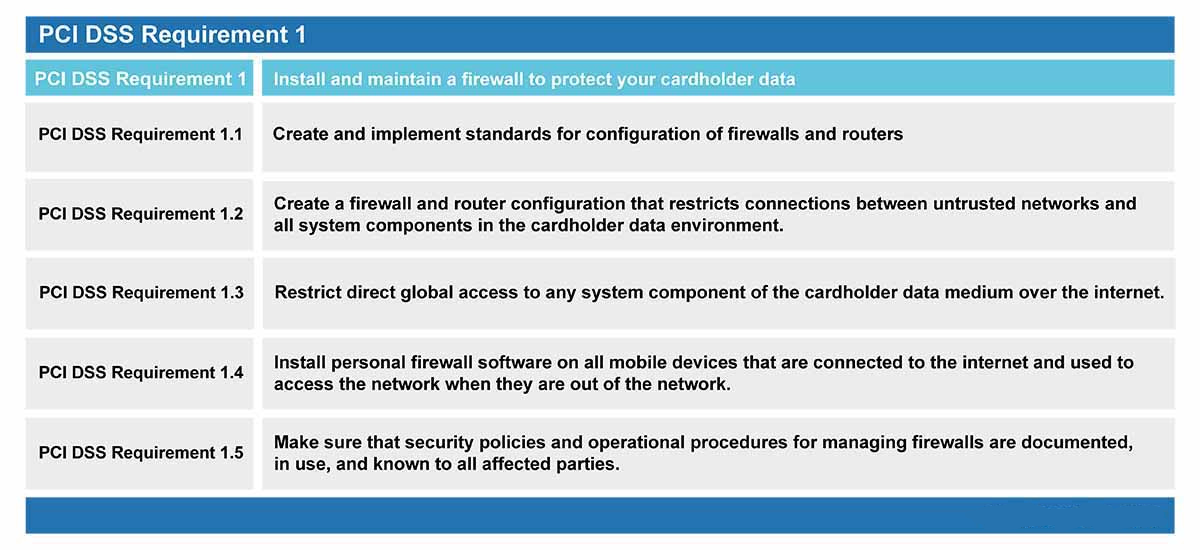PCI DSS Requirement 1: Protect cardholder data with a Firewall
 Basheer Ahamed
Basheer Ahamed

In the realm of Payment Card Industry Data Security Standard (PCI DSS), Requirement 1 holds a pivotal role, focusing on the establishment and management of firewalls as a shield for the cardholder data environment. Understanding the nuances of Requirement 1 is fundamental for any organization aiming for PCI compliance and, ultimately, safeguarding sensitive payment information.

Firewalls: Safeguarding the Digital Perimeter
Firewalls serve as vigilant sentinels, controlling the traffic flow between an organization's local network and external networks. Acting as gatekeepers, firewalls scrutinize all network traffic, permitting only authorized communication while thwarting unauthorized access attempts. The significance of firewalls extends beyond conventional defense; they strategically position in sensitive zones, fortifying the cardholder data environment against potential threats emanating from within the organization.
Essential Functions of Firewalls
Network Protection: Firewalls play a pivotal role in safeguarding various connections, including e-commerce systems, email communications, and internet access, shielding them from unauthorized intrusion.
Internal Network Segmentation: Placing firewalls within the internal network partitions the cardholder data environment, preventing data compromise by segregating it from other organizational networks.
Requirement 1.1: Strengthening Firewall and Router Configurations
1.1.1: Network Connection Confirmation Process
To fortify firewall integrity, organizations must establish a formal process to confirm and test all network connections and changes in firewall and router configurations. This structured approach prevents security vulnerabilities arising from improper network configurations.
1.1.2: Network Topology Diagrams
Creating network topology diagrams defining connections between the cardholder data environment and other networks is imperative. Up-to-date diagrams ensure comprehensive security checks, preventing overlooked devices from exposing the cardholder data environment to potential risks.
1.1.3: Card Data Flow Diagrams
Valid and current card data flow diagrams unveil the pathways of cardholder data across networks, facilitating a meticulous understanding and monitoring of data coverage. Regular updates to these diagrams keep pace with environmental changes, ensuring ongoing security.
1.1.4: Strategic Firewall Positioning
Firewalls strategically positioned between Internet connections, the Demilitarized Zone (DMZ), and the local network form a robust defense against unauthorized access. Aligning firewall configuration with standards and corroborating it with network topology diagrams minimizes the risk of misconfigurations.
1.1.5: Roles and Responsibilities Documentation
Delineating clear roles and responsibilities for the management of network components is crucial. This ensures that authorized personnel are cognizant of their duties, mitigating the risk of mismanagement and potential security lapses.
1.1.6: Security Measures for Services and Protocols
Documenting security measures for services and protocols, along with business rationales, is paramount. This prevents vulnerabilities stemming from unused or unsafe services and ports and ensures a secure implementation of necessary protocols.
1.1.7: Regular Firewall and Router Rule Reviews
Routine reviews of firewall and router rules, at least every six months, are imperative. This practice aids in eliminating obsolete or incorrect rules, maintaining relevance, and ensuring that rule sets align with documented business needs.
Requirement 1.2: Securing Connections within the Cardholder Data Environment
1.2.1: Limiting Inbound and Outbound Traffic
Imposing strict limitations on inbound and outbound traffic to only what is required for the cardholder data environment enhances control and prevents unfiltered access. Rejecting all other traffic ensures the exclusion of potentially harmful data.
1.2.2: Secure Storage and Synchronization of Router Configuration Files
Ensuring the secure storage and synchronization of router configuration files is vital. This prevents discrepancies between startup and running configurations, bolstering the overall security posture.
1.2.3: Wireless Network Protection
Placing firewalls between all wireless networks and the cardholder data environment is non-negotiable. This measure prevents unauthorized access through wireless connections, curbing potential data breaches.
Requirement 1.3: Controlling Internet Access and System Component Placement
1.3.1-2: Demilitarized Zone (DMZ) Establishment
Creating a DMZ to limit incoming traffic to system components offering authorized services, protocols, and ports is a strategic move. This prevents malicious individuals from exploiting internet-facing components, fortifying overall network security.
1.3.3: Anti-Spoofing Measures
Implementing anti-spoofing measures detects and prevents the entry of spoofed IP addresses into the network. This robust defense mechanism guards against deceptive attempts to infiltrate the organization's network.
1.3.4: Monitoring and Restricting Traffic from the Cardholder Data Environment
Evaluating all traffic from the cardholder data environment is paramount. Monitoring and restricting unauthorized connections ensure that traffic adheres to established rules, minimizing potential security threats.
1.3.5: Allowing Only "Established" Connections
Permitting only pre-established connections adds an additional layer of security. This ensures that connections are legitimate and prevents malicious attempts to manipulate firewall rules.
1.3.6: System Component Placement
Segregating system components that store cardholder data in a local network zone, separate from DMZ and untrusted networks, enhances security. This layered approach adds an additional barrier against unauthorized access.
1.3.7: Confidentiality of IP Addresses
Preventing the disclosure of private IP addresses and routing information to unauthorized parties is essential. Utilizing methods like Network Address Translation (NAT) or placing servers behind proxy servers/firewalls safeguards against potential network reconnaissance.
Requirement 1.4: Personal Firewall Software for Portable Devices
Installing personal firewall software on all portable computing devices accessing the internet outside the network is a prudent measure. This safeguards against internet-based attacks, ensuring the protection of devices and the data they access upon reconnection to the network.
Requirement 1.5: Documenting Security Policies and Operational Procedures
Ensuring that security policies and operational procedures for managing firewalls are documented, in use, and known to all affected parties is foundational. This knowledge dissemination empowers staff to adhere to security protocols, preventing unauthorized access and ensuring ongoing firewall management.
Meta description:
Explore the intricacies of PCI DSS Requirement 1, unraveling the importance of firewalls in protecting the cardholder data environment. Dive deep into sub-requirements, best practices, and strategic measures to fortify your organization's defense against potential security threats.
Don't miss out on my deep insights! Subscribe to my newsletter for regular updates on PCI DSS and stay informed about the latest trends and best practices.
Subscribe to my newsletter
Read articles from Basheer Ahamed directly inside your inbox. Subscribe to the newsletter, and don't miss out.
Written by

Basheer Ahamed
Basheer Ahamed
PCI DSS SME